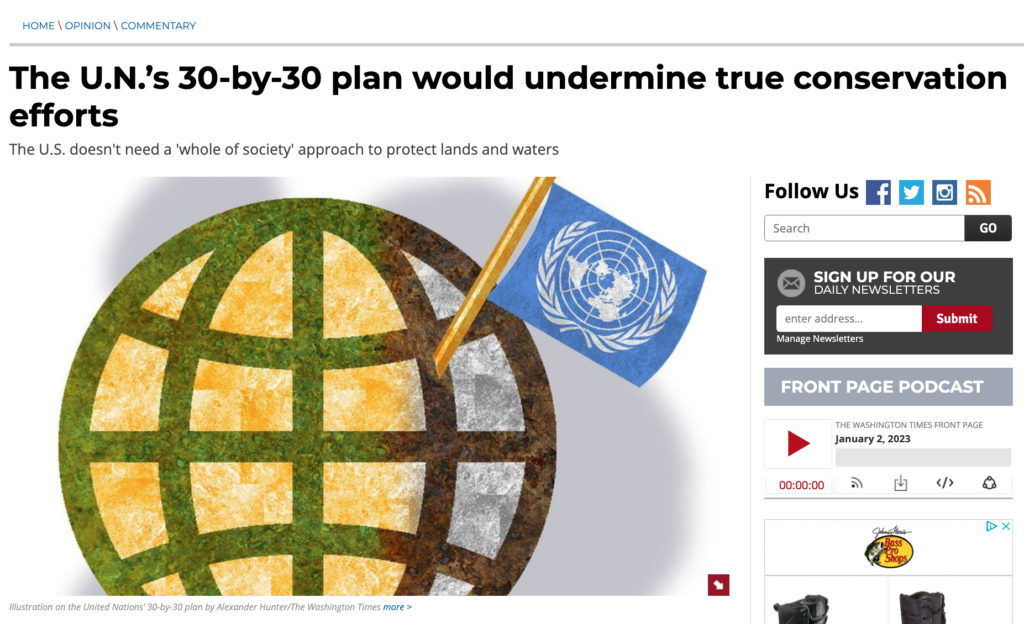Originally posted on Washington Times– January 2nd, 2023
The 15th annual United Nations Biodiversity Conference (COP15) in Montreal produced a far-reaching, “historic” Global Biodiversity Framework to conserve 30% of lands and 30% of waters by 2030.
With negotiations led by China, over 190 countries signed on to this bold yet nonbinding agreement. Strangely, the U.S. wasn’t involved in talks — despite the Biden administration’s touting of its own “America the Beautiful” initiative.
One has to believe, however, that President Biden’s administrative personnel are supportive.
Worse, it would undercut successful, true conservation practices already modeled here in the U.S.
The United States, an environmental leader, doesn’t need to take cues on administering conservation practices from the United Nations — an outfit stacked with communist and dictatorial regimes boasting horrific environmental records. Our nation already stewards its land well by employing multiple-use and private property strategies that encourage meaningful stakeholder involvement — especially that of sportsmen.
With respect to biodiversity, hunters and anglers (stakeholders conveniently ignored by the COP15 agreement) are the primary funders of conservation in the U.S. under the Pittman-Robertson Act. This law, since its implementation, has generated over $15 billion in conservation funding. Last year, $1.5 billion was generated and distributed to all 50 states.
Nor do we need more land set aside for the government to restrict access to. According to the U.S. Geological Survey’s Gap Analysis Project (GAP) on the Protected Areas Database of the U.S (PADUS), public lands comprising the Bureau of Land Management, National Park Service, U.S. Fish and Wildlife Service, and U.S. Forest Service federally shielded from multiple-use management amounts to 252,758,091 of 622,630,476 total acres. That’s 40.6% — well over the 30% requirement.
The most alarming of the 23 “targets” concocted at COP15 is the mandatory financial commitments needed to achieve its global 30-by-30 goals. Those in attendance “recommended” financial commitments totaling $200 billion annually. Inserted in this request, developed nations — including the U.S. — are expected to cough up “biodiversity-related international financial resources” up to $20 billion annually by 2025 and $30 billion annually by 2030, to pay the tab for developing nations.
Shelling out cash to fix perceived environmental problems is ripe for corruption, virtue signaling and grifting by the United Nations.
How will these monies be stewarded? How will they be immune to fraud? Will demands be evenly applied to participating countries? Predictably, they won’t.
With rising inflation and spending fatigue, Congress is unlikely to enshrine COP15 mandates into law. And Americans aren’t on board seeing their taxpayer dollars support an expensive, globalist environmental plan foisted by the U.N.
Those gathered at the U.N. Biodiversity Summit claim that businesses pose the greatest threat to biodiversity and, therefore, must repent for their sins of productivity. If they don’t protect nature in accordance with COP15 targets, the supposed ecological toll from economic activities will total $2.7 trillion annually.
To stymie businesses from extracting food and raw materials from Mother Earth, the COP15 agreement also calls for corporations and governments to adopt environmental, social and governance (ESG) reporting rules. These reporting guidelines were formulated by the International Sustainability Standards Board, an arm of the International Financial Reporting Standards Foundation.
Biodiversity reporting stipulates businesses must “regularly monitor, assess, and transparently disclose their risks, dependencies and impacts on biodiversity.” But the agreement was absent detailed metrics and won’t be available until this year.
Given the flawed reporting metrics, coupled with poor ESG fund performance, biodiversity funds and the accompanying reporting regime are expected to be flawed by forcing unrealistic behaviors on companies and individuals. Biodiversity-impact reporting, much like ESG-impact reporting, will be hard to implement. And tracking these particular metrics isn’t a new phenomenon.
As The Wall Street Journal reports, biodiversity reporting would be challenging to track since metrics are more subjective and difficult to score than carbon emissions.
In sum, individuals and companies can voluntarily conserve wetlands, protect flora and fauna, and boost natural resources without vague and lofty dictates from unaccountable global outfits.
The United States doesn’t need to follow a “whole of society” or “whole of government” approach to protect lands and waters. True conservation practices, rooted in free markets and private property rights, enable our nation to lead on this front without undermining economic prosperity.

